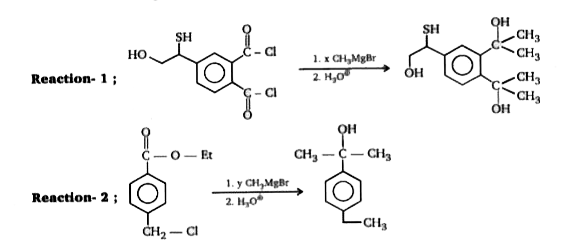The ratio of rates of diffusion of two gases x and y under similar conditions is 2:1. What will be the ratio of their average speeds if gas X is at −23∘C and gas y is at 273∘C?
To solve the problem, we will use the principles of diffusion and the relationship between the average speed of gases and their molecular weights and temperatures.
1. Understanding the Given Information:
- The ratio of the rates of diffusion of gas X to gas Y is given as 2:1.
- We need to find the ratio of their average speeds, given that gas X is at -23°C and gas Y is at 273°C.
2. Using Graham's Law of Effusion:
- According to Graham's law, the rate of diffusion (or effusion) of a gas is inversely proportional to the square root of its molecular weight (MW).
- Mathematically, this can be expressed as:
Rate of diffusion of XRate of diffusion of Y=√MWYMWX
- Given that the ratio of rates is 2:1, we can write:
2=√MWYMWX
3. Squaring Both Sides:
- Squaring both sides gives:
4=MWYMWX
- Rearranging this gives:
MWY=4×MWX
4. Calculating Average Speeds:
- The average speed (V) of a gas can be calculated using the formula:
V=√8RTπMW
- Here, R is the universal gas constant, T is the temperature in Kelvin, and MW is the molecular weight of the gas.
5. Converting Temperatures to Kelvin:
- For gas X at -23°C:
TX=−23+273=250K
- For gas Y at 273°C:
TY=273+273=546K
6. Finding the Average Speeds:
- The average speed of gas X:
VX=√8R⋅250πMWX
- The average speed of gas Y:
VY=√8R⋅546πMWY
7. Taking the Ratio of Average Speeds:
- The ratio of the average speeds VXVY can be expressed as:
VXVY=√8R⋅250πMWX√8R⋅546πMWY
- This simplifies to:
VXVY=√250⋅MWY546⋅MWX
8. Substituting the Molecular Weight Relationship:
- From step 3, we know MWY=4×MWX. Substituting this in gives:
VXVY=√250⋅(4⋅MWX)546⋅MWX
- The MWX cancels out:
VXVY=√1000546=√1.83≈1.35
9. Final Ratio:
- Therefore, the ratio of the average speeds of gases X and Y is approximately:
VX:VY≈1.35:1
- The ratio of the rates of diffusion of gas X to gas Y is given as 2:1.
- We need to find the ratio of their average speeds, given that gas X is at -23°C and gas Y is at 273°C.
- According to Graham's law, the rate of diffusion (or effusion) of a gas is inversely proportional to the square root of its molecular weight (MW).
- Mathematically, this can be expressed as:
Rate of diffusion of XRate of diffusion of Y=√MWYMWX
- Given that the ratio of rates is 2:1, we can write:
2=√MWYMWX
- Squaring both sides gives:
4=MWYMWX
- Rearranging this gives:
MWY=4×MWX
- The average speed (V) of a gas can be calculated using the formula:
V=√8RTπMW
- Here, R is the universal gas constant, T is the temperature in Kelvin, and MW is the molecular weight of the gas.
- For gas X at -23°C:
TX=−23+273=250K
- For gas Y at 273°C:
TY=273+273=546K
- The average speed of gas X:
VX=√8R⋅250πMWX
- The average speed of gas Y:
VY=√8R⋅546πMWY
- The ratio of the average speeds VXVY can be expressed as:
VXVY=√8R⋅250πMWX√8R⋅546πMWY
- This simplifies to:
VXVY=√250⋅MWY546⋅MWX
- From step 3, we know MWY=4×MWX. Substituting this in gives:
VXVY=√250⋅(4⋅MWX)546⋅MWX
- The MWX cancels out:
VXVY=√1000546=√1.83≈1.35
- Therefore, the ratio of the average speeds of gases X and Y is approximately:
VX:VY≈1.35:1
Similar Questions
Knowledge Check

What is the ratio of (x/y) in above problem ?A1.5B2C2.5D3
Ratio of the average speed of He and SO2 at 27o C will be
View SolutionIf the ratio of molar masses of two gases A and B is 1 : 4. What is the ratio of the average speeds ?
View SolutionWhat is the ratio of rate of diffusion of gas A and B. The molecular mass of A is 11 and molecular mass of B is 44.
View SolutionRatio of the rate of diffusion of He to H2 at 0∘C is same in the case :
View SolutionThe rate of diffusion of two gases A and B is in the ratio of 1:4 and that of B and C in the ratio of 1:3. The rate of diffusion of C with respect to A is
View SolutionThe rate of diffusion of two gases X and Y is in the ration of 1:5 and that of Y and Z in the ratio of 1:6. The ratio of the rate of diffusion of Z with respecte to X is :
View SolutionA. Rate of diffusion of H2 is 1.44 times of He.
R: Under similar conditions of temperature and pressure all gases diffuse with same velocity.
View Solution